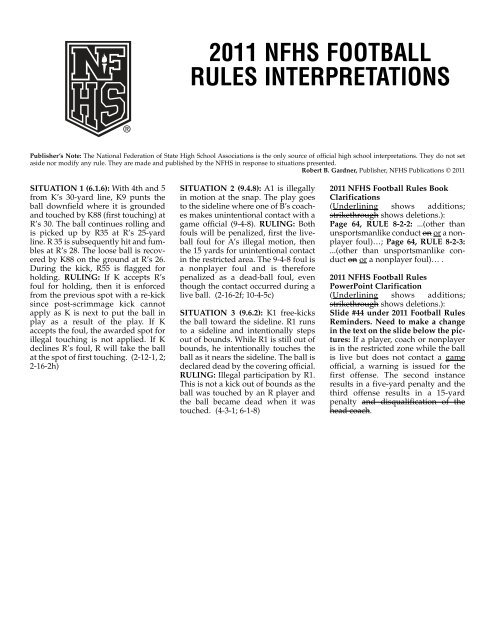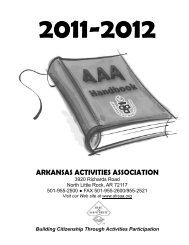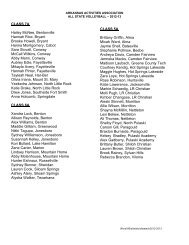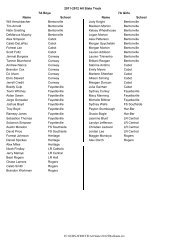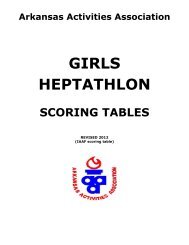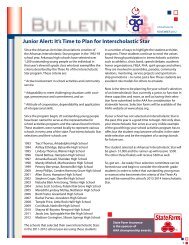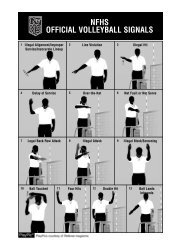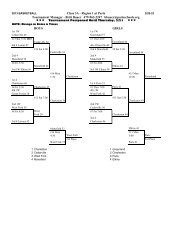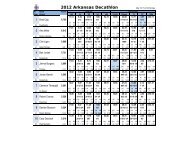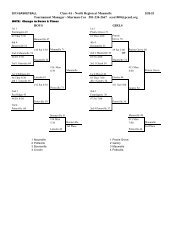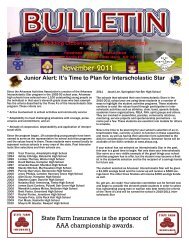2011 nfhs football rules interpretations - Utah High School Activities ...
2011 nfhs football rules interpretations - Utah High School Activities ...
2011 nfhs football rules interpretations - Utah High School Activities ...
Create successful ePaper yourself
Turn your PDF publications into a flip-book with our unique Google optimized e-Paper software.
®<br />
SITUATION 1 (6.1.6): With 4th and 5<br />
from K’s 30-yard line, K9 punts the<br />
ball downfield where it is grounded<br />
and touched by K88 (first touching) at<br />
R’s 30. The ball continues rolling and<br />
is picked up by R35 at R’s 25-yard<br />
line. R 35 is subsequently hit and fumbles<br />
at R’s 28. The loose ball is recovered<br />
by K88 on the ground at R’s 26.<br />
During the kick, R55 is flagged for<br />
holding. RULING: If K accepts R’s<br />
foul for holding, then it is enforced<br />
from the previous spot with a re-kick<br />
since post-scrimmage kick cannot<br />
apply as K is next to put the ball in<br />
play as a result of the play. If K<br />
accepts the foul, the awarded spot for<br />
illegal touching is not applied. If K<br />
declines R’s foul, R will take the ball<br />
at the spot of first touching. (2-12-1, 2;<br />
2-16-2h)<br />
<strong>2011</strong> NFHS FOOTBALL<br />
RULES INTERPRETATIONS<br />
Publisher’s Note: The National Federation of State <strong>High</strong> <strong>School</strong> Associations is the only source of official high school <strong>interpretations</strong>. They do not set<br />
aside nor modify any rule. They are made and published by the NFHS in response to situations presented.<br />
Robert B. Gardner, Publisher, NFHS Publications © <strong>2011</strong><br />
SITUATION 2 (9.4.8): A1 is illegally<br />
in motion at the snap. The play goes<br />
to the sideline where one of B’s coaches<br />
makes unintentional contact with a<br />
game official (9-4-8). RULING: Both<br />
fouls will be penalized, first the liveball<br />
foul for A’s illegal motion, then<br />
the 15 yards for unintentional contact<br />
in the restricted area. The 9-4-8 foul is<br />
a nonplayer foul and is therefore<br />
penalized as a dead-ball foul, even<br />
though the contact occurred during a<br />
live ball. (2-16-2f; 10-4-5c)<br />
SITUATION 3 (9.6.2): K1 free-kicks<br />
the ball toward the sideline. R1 runs<br />
to a sideline and intentionally steps<br />
out of bounds. While R1 is still out of<br />
bounds, he intentionally touches the<br />
ball as it nears the sideline. The ball is<br />
declared dead by the covering official.<br />
RULING: Illegal participation by R1.<br />
This is not a kick out of bounds as the<br />
ball was touched by an R player and<br />
the ball became dead when it was<br />
touched. (4-3-1; 6-1-8)<br />
<strong>2011</strong> NFHS Football Rules Book<br />
Clarifications<br />
(Underlining shows additions;<br />
strikethrough shows deletions.):<br />
Page 64, RULE 8-2-2: ...(other than<br />
unsportsmanlike conduct on or a nonplayer<br />
foul)…; Page 64, RULE 8-2-3:<br />
...(other than unsportsmanlike conduct<br />
on or a nonplayer foul)… .<br />
<strong>2011</strong> NFHS Football Rules<br />
PowerPoint Clarification<br />
(Underlining shows additions;<br />
strikethrough shows deletions.):<br />
Slide #44 under <strong>2011</strong> Football Rules<br />
Reminders. Need to make a change<br />
in the text on the slide below the pictures:<br />
If a player, coach or nonplayer<br />
is in the restricted zone while the ball<br />
is live but does not contact a game<br />
official, a warning is issued for the<br />
first offense. The second instance<br />
results in a five-yard penalty and the<br />
third offense results in a 15-yard<br />
penalty and disqualification of the<br />
head coach.
®<br />
SITUATION 1: A player who is not<br />
listed on the roster scores a goal. The<br />
goal is allowed. RULING: Legal.<br />
Since players may be added to the<br />
roster after the start of play, a goal by<br />
a player who is not on the roster<br />
should be allowed and the player’s<br />
name and number should be added to<br />
the roster. (3-1-3 Situation A)<br />
SITUATION 2: Team A arrives wearing<br />
striped jerseys that have large,<br />
light blue- and white alternating<br />
stripes. Two members of Team A are<br />
wearing visible light red T-shirts<br />
beneath their jerseys. RULING:<br />
Legal. Striped jerseys are permissible<br />
for the visiting team as long as the<br />
predominate color is dark. Jerseys<br />
with equal-sized stripes that have<br />
both dark and white stripes do not<br />
have a predominant dark color and<br />
would be illegal. Also, shirts may be<br />
worn under the jersey as long as the<br />
shirts are the same color and of similar<br />
length. (4-1-1 Situation D)<br />
SITUATION 3: During play, bench<br />
personnel are required by officials to<br />
wear pinnies while warming up outside<br />
the team area. RULING: False. It<br />
is recommended. (4-1-1 Situation K)<br />
SITUATION 4: During the game, the<br />
referee notices a goalkeeper wearing<br />
(a) shorts, (b) pants and (c) padded<br />
goalkeeper pants. RULING: Legal in<br />
(a), (b) and (c). (4-1-1 Situation L)<br />
<strong>2011</strong>-12 NFHS SOCCER<br />
RULES INTERPRETATIONS<br />
Publisher’s Note: The National Federation of State <strong>High</strong> <strong>School</strong> Associations is the only source of official high school <strong>interpretations</strong>. They do not set<br />
aside nor modify any rule. They are made and published by the NFHS in response to situations presented.<br />
Robert B. Gardner, Publisher, NFHS Publications © <strong>2011</strong><br />
SITUATION 5: Prior to the start of<br />
the contest, the referee meets with the<br />
teams’ head coaches and captains and<br />
after reciting a sportsmanship message<br />
asks both head coaches if their<br />
teams are properly and legally<br />
equipped according to NFHS Soccer<br />
Rules. Each coach answers in the affirmative.<br />
(a) After the contest has started,<br />
Player A is noticed to have a shinguard<br />
that has the NOCSAE seal indicating<br />
that the shinguard is undersized<br />
for the player’s height; (b) after<br />
the second half starts, Player A is<br />
noticed to be wearing illegal jewelry;<br />
(c) during the course of play, a knee<br />
brace is dislodged by a collision<br />
between two players. RULING: In (a)<br />
and (b), if it is the first offense, the<br />
player is sent off the field and cannot<br />
re-enter until the next legal substitution<br />
opportunity, and the coach of<br />
Team A is cautioned for the team not<br />
being legally equipped. If it is the second<br />
offense, the player is cautioned.<br />
In (c), player is not cautioned, leaves<br />
the field and may re-enter after<br />
reporting to an official, who shall be<br />
satisfied that the knee brace is now in<br />
order. (4-3 Situation A)<br />
SITUATION 6: The game is terminated<br />
by the head referee due to a fight<br />
among players of both teams and (a)<br />
the team trailing started the fight; (b)<br />
the team leading started the fight; (c)<br />
the score is tied. RULING: In (a), (b)<br />
and (c), no winner is declared by the<br />
official and all conditions regarding<br />
the incident shall be reported to the<br />
proper authorities in writing. (5-3-2<br />
Situation B)<br />
SITUATION 7: During the match, (a)<br />
A1 commits a foul in a reckless manner,<br />
(b) A1 is the second player from<br />
Team A observed with illegal equipment<br />
and (c) after scoring a goal, A1<br />
celebrates excessively. RULING: (a),<br />
(b) and (c), caution A1 for unsporting<br />
conduct. (12-8-1 Situation B)<br />
SITUATION 8: Player A2 is moving<br />
toward his opponent’s goal with an<br />
obvious chance to score a goal when<br />
he is taken down by the jersey by<br />
player B2 (a) outside the penalty area;<br />
(b) inside the penalty area. RULING:<br />
Illegal in (a) or (b) and the offending<br />
player is disqualified for serious foul<br />
play whether or not a goal is subsequently<br />
scored. Penalty in (a) will be a<br />
direct free kick and in (b) a penalty<br />
kick unless a goal was scored, in<br />
which case a kickoff will be the<br />
restart. (12-8-3 Situation E)
®<br />
SITUATION 1: What is the penalty if<br />
an element ends in a dead hang and<br />
the gymnast uses extra swings to<br />
regain momentum? RULING: If an<br />
element is performed poorly and it<br />
ends in a dead hang, the maximum<br />
deduction of 0.6 is taken if more than<br />
two consecutive extra swings are<br />
used to create momentum. More than<br />
two consecutive extra swings are not<br />
penalized. If there are more than two<br />
consecutive extra swings, only deduct<br />
for two extra swings, which equals<br />
0.6. It is possible to take the extra<br />
swing deduction on several elements<br />
in a routine. The only restriction is<br />
that no more than two consecutive<br />
extra swings should be taken on a single<br />
element. If the gymnast then continues<br />
on and does another element<br />
and does an extra swing, then a 0.3<br />
deduction would be taken. If the<br />
gymnast continues on after that and<br />
does two consecutive extra swings on<br />
a single element, the maximum<br />
deduction for extra swings for that<br />
element is 0.6. (7-3-4c)<br />
SITUATION 2: What is the deduction<br />
for pump swings used to create<br />
momentum after a fall? RULING:<br />
After a fall, the gymnast is allowed to<br />
jump (or be lifted) to the high bar and<br />
then take a maximum of two pump<br />
swings to initiate momentum to<br />
resume the exercise. If more than two<br />
pump swings are taken, a 0.3 deduction<br />
for each extra swing(s) would be<br />
applied up to 0.6. (Page 92, #4)<br />
SITUATION 3: Is a swing ½ turn a<br />
direction change on bars? RULING:<br />
No. A direction change is defined as<br />
the body turning/twisting and moving<br />
in the opposite direction within an<br />
element of value. Element number<br />
8.106 describes a swing that moves<br />
<strong>2011</strong>-12 NFHS<br />
GIRLS GYMNASTICS<br />
RULES INTERPRETATIONS<br />
Publisher’s Note: The National Federation of State <strong>High</strong> <strong>School</strong> Associations is the only source of official high school <strong>interpretations</strong>. They do not set<br />
aside nor modify any rule. They are made and published by the NFHS in response to situations presented.<br />
Robert B. Gardner, Publisher, NFHS Publications © <strong>2011</strong><br />
down between the bars, swings forward<br />
with ½ turn (180 degrees) at 45<br />
degrees from vertical. If the execution<br />
of element 8.106 does not precisely<br />
meet these specifications, including<br />
the turn executed at 45 degrees deviation<br />
from vertical, then it will not<br />
receive medium Value Part credit<br />
because it will not be an element of<br />
value. (1)<br />
SITUATION 4: On bars, is a drop kip<br />
one or two bar changes? RULING: A<br />
gymnast must move from one bar to<br />
another bar to be considered one bar<br />
change. Therefore, a drop kip is one<br />
bar change. (7-3-3b)<br />
SITUATION 5: On bars, what is the<br />
difference between the LA twist/turn<br />
and a direction change? RULING:<br />
The LA twist/turn is an event requirement<br />
worth 0.2. Any element that<br />
turns or twists around the longitudinal<br />
axis of the body except for the<br />
mount and dismount counts as an LA<br />
twist/turn. Elements that turn 180<br />
degrees, 360 degrees, 540 degrees and<br />
720 degrees or more fulfill this<br />
requirement. A direction change is a<br />
composition requirement worth .05.<br />
A direction change requires that the<br />
twist/turn around the longitudinal<br />
axis comes from an element of value<br />
and moves in the opposite direction.<br />
Only 180-degrees or 540-degrees<br />
turns move in the opposite direction.<br />
A direction change cannot be part of<br />
the mount or dismount. (7-2-2b, 7-3-<br />
3b)<br />
SITUATION 6: On bars, can an<br />
attempt at a giant with a ½ turn, using<br />
the Higgins technique, count for the<br />
direction change if the turn is started<br />
past 45 degrees deviation from vertical<br />
and completed near the bottom of<br />
the swing. RULING: No. The turn as<br />
described is no longer considered part<br />
of the giant and therefore the element<br />
is not a giant with a ½ turn. The turn,<br />
in this instance, is not a part of the<br />
giant nor is it a part of the dismount.<br />
The element is a giant and is given a<br />
value of high superior. (7-4, Fig. 2)<br />
SITUATION 7: On beam, can an<br />
inquiry be filed regarding the acro<br />
direction change requirement in composition?<br />
RULING: No. The acro<br />
direction change requirement is a<br />
composition requirement and composition<br />
cannot be inquired. (5-1-4)<br />
SITUATION 8: On floor exercise,<br />
how do you determine the shape of a<br />
leap or jump? RULING: The shape of<br />
a leap or jump is determined at the<br />
apex (highest point) to the finish<br />
(landing). (1)<br />
SITUATION 9: May floor exercise<br />
music contain human sounds or<br />
singing? RULING: The musical<br />
accompaniment must be recorded<br />
with orchestration, piano or other<br />
instruments (without singing).<br />
Human sounds are allowed, provided<br />
there are no words spoken or sung.<br />
There is a 1.0 chief judge deduction<br />
for absence of music or music with<br />
voice or song/speech. (9-3-7o)
®<br />
Corrections to Rules Book: 9-8-2e<br />
should read “not holding the straight<br />
position on a flying somersault until<br />
the body is horizontal, and on a flying<br />
1½ somersault holding the straight<br />
position until the body is vertical, to<br />
the surface of the water;”<br />
SITUATION 1: A diver, after taking<br />
two steps on his/her forward<br />
approach, jumps off two feet before a<br />
third step, followed by a culminating<br />
hurdle and takeoff from both feet<br />
simultaneously at the end of the<br />
board and high enough to perform<br />
the dive. RULING: Violation of the<br />
forward approach, diving referee<br />
shall deduct two points from each<br />
judge’s award. COMMENT: The<br />
diver is required a minimum of three<br />
steps before he/she may use additional<br />
steps, hops, leaps and/or<br />
jumps before the culminating hurdle.<br />
(9-5-2, 9-8-1a)<br />
SITUATION 2: Team A has a foreign<br />
exchange student on the team.<br />
He/she would like to wear his/her<br />
country’s flag on the competition suit.<br />
The size of the flag is 3x4 inches.<br />
<strong>2011</strong>-12 NFHS<br />
SWIMMING AND DIVING<br />
RULES INTERPRETATIONS<br />
Publisher’s Note: The National Federation of State <strong>High</strong> <strong>School</strong> Associations is the only source of official high school <strong>interpretations</strong>. They do not set<br />
aside nor modify any rule. They are made and published by the NFHS in response to situations presented.<br />
Robert B. Gardner, Publisher, NFHS Publications © <strong>2011</strong><br />
Team A’s coach will not allow the flag<br />
to be worn because it exceeds the size<br />
of an American flag. If the flag was no<br />
larger than 2x3 inches and the state<br />
association did not have a policy prohibiting<br />
the flag, the foreign flag<br />
could be worn. RULING: Correct.<br />
COMMENT: Even though the rule is<br />
specific to the American flag, the<br />
coach responded to the student within<br />
the spirit of the rule and checked<br />
with the state association. Only one<br />
flag is permitted. (3-3-2d)<br />
SITUATION 3: The conference championship<br />
swimming and diving meet<br />
will be hosted by <strong>School</strong> A. The conference<br />
schools want to use just the<br />
default method of establishing the<br />
dive order for this 11 dive meet.<br />
Unless determined otherwise by the<br />
meet director, the default method for<br />
determining the order of the dive<br />
competition for a championship meet<br />
or meet conducted under a championship<br />
format shall be by lot. RUL-<br />
ING: Correct procedure. (9-2-2)<br />
SITUATION 4: The lane timer in lane<br />
5 reports that the swimmer missed the<br />
Lane Primary Pad Button A Watch A Watch B Pad Minus Official<br />
Button A Time<br />
1 52.02 52.17 52.24 52.20 -0.15 52.02<br />
2 52.03 52.14 52.11 52.16 -0.11 52.03<br />
3 51.05 51.10 51.02 51.11 -0.05 51.05<br />
4 50.88 50.98 51.01 50.96 -0.10 50.88<br />
5 52.42 51.99 52.00 51.98 0.43 51.96 Late Touch Reported<br />
6 51.29 51.37 51.51 51.41 -0.08 51.29<br />
7 52.15 52.23 52.28 52.31 -0.08 52.15<br />
8 51.87 51.92 52.01 52.02 -0.05 51.87<br />
-0.19 -0.03<br />
touchpad at the finish, which had<br />
moved from proper position. The referee<br />
integrates the back-up time for<br />
lane 5 of the heat. RULING: Correct<br />
procedure. COMMENT: See lane<br />
malfunction chart below. (6-4-1)<br />
SITUATION 5: Now that the order of<br />
diving can be by lot or seeded based<br />
on the best 11 dive score submitted for<br />
the current season in a championship<br />
meet or meet conducted under a<br />
championship format, who has the<br />
authority to determine the method to<br />
place the divers in order at a) an<br />
invitational meet conducted under<br />
championship format; b) the conference/league<br />
championship meet; and<br />
c) the state series? RULING: In a), it<br />
will be the meet director; b) the meet<br />
director or by conference policy defer<br />
to the meet committee; and c) determined<br />
by the state association or<br />
could defer to the meet director or<br />
meet committee. COMMENT: In all<br />
situations, the manner of determining<br />
the diving order should be communicated<br />
to all participating schools in<br />
advance. (9-2-2)<br />
Adjustment calculation<br />
– calculate the average<br />
difference between the<br />
valid primary and valid<br />
back-up times of the<br />
other lanes in the heat.<br />
The average will be<br />
added or subtracted<br />
from the valid back-up<br />
time of the lane that has<br />
the malfunction. (If the<br />
average difference is a<br />
minus number, it is subtracted<br />
from the backup<br />
time.)
®<br />
Corrections to Rules Book: Page 3 –<br />
Editorial Changes 4-1-8 should be 4<br />
NOTE 2; Page 48 – Points of Emphasis<br />
#4: Suspended Net Systems, line 5<br />
should read: “A system also having<br />
poles on one side of the net used to<br />
retract the system may result in<br />
a replay when contacted by the<br />
ball.”; Page 60 should read “#1 Illegal<br />
Alignment/Improper<br />
Server/Inaccurate Lineup”<br />
Corrections to Case Book and<br />
Manual: None.<br />
Corrections to Preseason Guide:<br />
None.<br />
SITUATION 1: Team A, with five<br />
players, has just been awarded a loss<br />
of rally/point and the ball for next<br />
serve. However, the vacant position<br />
rotates to right back position. The first<br />
referee whistles and immediately<br />
awards a loss of rally/point and the<br />
ball returns to Team B. RULING:<br />
Correct procedure. COMMENT:<br />
There is no signal for the vacant position<br />
other than when the team with<br />
five players receives the ball to serve.<br />
After a pause the first referee whistles,<br />
signals awarding loss of<br />
rally/point and immediately returns<br />
the ball to the opponent. (1-3-3)<br />
SITUATION 2: Team A arrives at<br />
Team B’s school and as it begins<br />
warm-ups the head coach of Team A<br />
notices that there is a white sleeve<br />
located across the top of the net that<br />
has “SOUTH HIGH SCHOOL<br />
EAGLES” in three locations across the<br />
net sleeve on both sides. The head<br />
coach of Team A approaches the R1<br />
questioning the use of the sleeve. The<br />
R1 confirms that the sleeve is no<br />
<strong>2011</strong>-12 NFHS VOLLEYBALL<br />
RULES INTERPRETATIONS<br />
Publisher’s Note: The National Federation of State <strong>High</strong> <strong>School</strong> Associations is the only source of official high school <strong>interpretations</strong>. They do not set<br />
aside nor modify any rule. They are made and published by the NFHS in response to situations presented.<br />
Robert B. Gardner, Publisher, NFHS Publications © <strong>2011</strong><br />
wider that 3 3/8 inches, does not<br />
interfere with the height of the net or<br />
play and is, therefore, legal under<br />
Rule 3-1-1. RULING: Correct procedure.<br />
COMMENT: The use of a white<br />
net sleeve is now permitted on the top<br />
of the net providing it is no wider<br />
than 3 3/8 inches and may display the<br />
school name, insignia, mascot and/or<br />
advertising professionally printed or<br />
by way of a decal on the sleeve.<br />
When using a net sleeve, it shall be<br />
secured so it does not affect the net<br />
height or interfere with play. (3-1-1)<br />
SITUATION 3: During the second<br />
set, the volleyball becomes lodged in<br />
the gymnasium ceiling rafters and<br />
cannot be returned to play. The ball is<br />
red, white and blue. The host school<br />
has an all-white volleyball and another<br />
red, white and blue volleyball that<br />
can be used. The visiting coach would<br />
like to use an all-white volleyball. The<br />
R1 requires the red, white and blue<br />
volleyball to be used as that was the<br />
original color and model of the competition<br />
volleyball. RULING: Correct<br />
procedure. COMMENT: The referees<br />
should make the effort to have the<br />
same color(s) of volleyball used<br />
throughout play. If this cannot be<br />
done, the R1, unless determined otherwise<br />
by state association policy, has<br />
the authority to approve a replacement<br />
volleyball. It is suggested the<br />
host school have at least one extra<br />
game ball available for play at all contests.<br />
(3-2, 5-3-1b)<br />
SITUATION 4: At the prematch conference,<br />
the head coach for Team B<br />
requests the R1 to look at the hair<br />
clips some of the players want to wear<br />
during competition and confirm if<br />
they may be worn. The flat clips, no<br />
longer than two inches, are (a) painted<br />
orange with a small tiger head<br />
painted on the clip as well or (b)<br />
painted orange with a small tiger<br />
head hot glued on the flat clip. RUL-<br />
ING: The R1 <strong>rules</strong> the flat clips in (a)<br />
are legal as the painting and design<br />
have not changed the flat integrity of<br />
the clip and in (b) the clips are illegal<br />
as the addition of the tiger head raises<br />
up above the clip and changes the flat<br />
integrity of the clip. (4-1-5)<br />
SITUATION 5: Team A, due to an<br />
injury, will be completing the set with<br />
only five players. The vacant position<br />
is currently the LF. The LB will be<br />
coming up as the back-row setter. The<br />
LB may go all the way to the net as<br />
there is not a LF player to overlap.<br />
RULING: Correct procedure. COM-<br />
MENT: With no front-row player,<br />
there is no potential overlap between<br />
the LB and LF. (6-4-3b)<br />
SITUATION 6: The coach from Team<br />
B fails to submit a complete and written,<br />
accurate numeric lineup to the<br />
scorer within the prescribed time limit<br />
for the second set. It is necessary for<br />
the penalty under Rule 7-1 – loss of<br />
rally/point being awarded to the<br />
opponent at the start of the next set –<br />
to be invoked. After the R2 signals<br />
ready to play to the R1 and prior to<br />
the signal and whistle for serve, the<br />
R2 whistles and signals inaccurate<br />
lineup using Signal #1 with the R1<br />
then mirroring the signal. RULING:<br />
Correct procedure. (7-1-Penalty,<br />
Official Signal No. 1)<br />
SITUATION 7: A back-row player is<br />
completing an attack from in front of<br />
the attack line and the ball is completely<br />
above the height of the net at
contact and the ball completely crosses<br />
the net. RULING: Illegal attack. (9-<br />
5-1b, 9-5-4, 9-5-5b, 9-5-5 Note, Official<br />
Signal No. 8)<br />
SITUATION 8: A back-row player is<br />
completing an attack from in front of<br />
the attack line and the ball is completely<br />
above the height of the net at<br />
contact and the ball is legally blocked<br />
by the opponents. RULING: Illegal<br />
attack. (9-5-1b, 9-5-4, 9-5-5b, 9-5-5<br />
Note, Official Signal No. 8)<br />
SITUATION 9: A back-row player on<br />
Team A is completing an attack in<br />
front of the attack line and the ball is<br />
completely above the height of the net<br />
at the moment of contact. Team B’s<br />
block consists of a front-row player<br />
and a back-row player as they contact<br />
the ball on the block. RULING:<br />
Double foul and a replay is called.<br />
COMMENT: In this situation there is<br />
an illegal attack by Team A’s back-row<br />
player and an illegal block by Team<br />
B’s back-row player. (9-5-1b, 9-5-4, 9-<br />
5-5b, 9-5-5 Note, 9-7-2)<br />
SITUATION 10: A back-row player<br />
who is making Team A’s second contact<br />
is in front of the attack line and<br />
the ball is completely above the<br />
height of the net at the moment of<br />
contact. The back-row player misshits<br />
the ball, and it is clearly not going<br />
to cross the net. Although there is a<br />
Team A player in the vicinity who<br />
could make Team A’s third team contact,<br />
the Team B front-row players<br />
reach completely over the net to block<br />
the ball before the ball enters the<br />
plane of the net. RULING: Illegal<br />
block. COMMENT: The only foul that<br />
has occurred is the illegal block as the<br />
Team A back-row player did not execute<br />
an attack hit as defined in Rule 9-<br />
5-1. (9-6-4)


